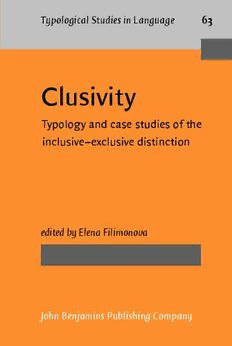
Clusivity: Typology and Case Studies of Inclusive-Exclusive Distinction PDF
451 Pages·1999·3.232 MB·Typological Studies in Language 63
Most books are stored in the elastic cloud where traffic is expensive. For this reason, we have a limit on daily download.
Preview Clusivity: Typology and Case Studies of Inclusive-Exclusive Distinction
Description:
This book presents a collection of papers on clusivity, a newly coined term for the inclusive–exclusive distinction. Clusivity is a widespread feature familiar from descriptive grammars and frequently figuring in typological schemes and diachronic scenarios. However, no comprehensive exploration of it has been available so far. This book is intended to make the first step towards a better understanding of the inclusive–exclusive opposition, by documenting the current linguistic knowledge on the topic.The issues discussed include the categorial and paradigmatic status of the opposition, its geographical distribution, realization in free vs bound pronouns, inclusive imperatives, clusivity in the 2nd person, honorific uses of the distinction, etc. These case studies are complemented by the analysis of the opposition in American Sign Language as opposed to spoken languages. In-depth areal and family surveys of clusivity consider this opposition in Austronesian, Tibeto-Burman, central-western South American, Turkic languages, and in Mosetenan and Shuswap.
See more
The list of books you might like
Most books are stored in the elastic cloud where traffic is expensive. For this reason, we have a limit on daily download.
